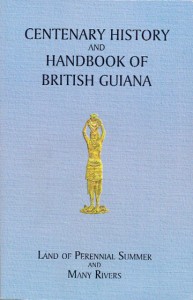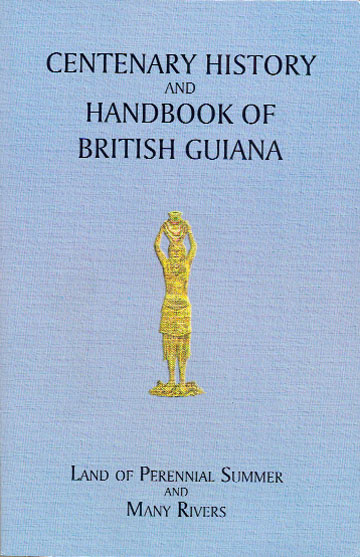Reprinting the past
ARF Webber Centenary history and handbook of British Guiana. [Georgetown : Guyana Heritage Society, 2008]
The Guyana Heritage Society recently re-published ARF Webber’s Centenary History and Handbook of British Guiana, which was first published by the Argosy Company in 1931. While the original edition was hardback, and the new one is paperback, it nevertheless faithfully reproduces the format and content of the 1931 imprint, including the contemporary advertisements on the preliminary and end pages.
Of particular importance are the full colour reproductions of RG Sharples’ bold water colours, an unusual feature in local books of the period, which invariably confined themselves to sepia or black and white. These are of great interest in their own right in terms of the history of art in this country, since their subject matter is local scenes. They are augmented by the black and white plates of various locations which appear in all the handbooks of the day.
The work itself, as its name indicates, was intended to remember one hundred years of British Guiana. It does not, however, confine itself to the century which inspired its title; it begins rather daringly perhaps with the date 1581 as representing the beginning of Dutch settlement here.
In terms of the Centenary History’s content – particularly for the earlier period – accuracy depended on the quality of the secondary sources on which Webber relied, and inevitably our historical understanding of some occurrences has moved on considerably since his day, while hardly surprisingly either, our perspective on events is often different. However, the author tended to approach his subject with a large brush, and his material, therefore, has something of the quality of a chronological survey for easy reference purposes, rather than a modern analytical history, although it must be said there are many portions where a considerable amount of detail has been provided.
Webber himself refers in the Preface to his emphasis on chronological sequence and the fact that he devoted chapters to periods rather than to “persons and the progressive development of policies and provinces.” What he did, therefore, was to provide an overview of the colonial framework for events, and within these limits his book still retains its usefulness.
What modern readers find most jarring in older works is the treatment of slavery. However, Webber went out of his way to avoid the topic, although he did not succeed completely. He says in the Preface that his book “does not profess to be a History of Slavery, or the slave times; therefore the lurid records of those days find little place in the following Chapters… Records of the grosser cruelties, the criminal practices, the repulsive customs of the day, will not be found in the following pages; save when they become necessary to illustrate some point at issue.”
The other elements of a traditional handbook are located at the back of the work in the form of appendices, and include production statistics, immigration statistics, the names of governors, imports and exports, geography and geology, etc.
 The new edition of the Centenary History… supplies a useful brief biography of the author, who had been born in Tobago in 1880, and who had migrated to the then British Guiana at the age of twenty. He spent the remainder of his life here first as an employee in the business sector, then in mining and subsequently in the advertising department of the Daily Argosy and later in Booker Bros.
The new edition of the Centenary History… supplies a useful brief biography of the author, who had been born in Tobago in 1880, and who had migrated to the then British Guiana at the age of twenty. He spent the remainder of his life here first as an employee in the business sector, then in mining and subsequently in the advertising department of the Daily Argosy and later in Booker Bros.
From there, we are told, the versatile Webber moved into politics, sitting as an elected member in the Combined Court in the first half of the 1920s, and leading the Popular Party of the time, among other things. He was also known as a naturalist and a journalist, being an editor of the Daily Chronicle and after that the New Daily Chronicle.
If that were not enough to fill one man’s lifetime, the biography tells us that he also published a novel about Indian indenture as well as poetry. He died suddenly in 1932.
Earlier local imprints have a poorer survival rate than works about this country published in the metropolis, and it is important that as many of the first in particular be rescued from obscurity through the agency of reprinting, so we recapture an awareness of the publishing traditions of this country. (Which does not mean to say that we should not also be reprinting rare books in the second category.) It should be added that in this case the new edition of the Centenary History… makes a contribution to our understanding of the local historiographical tradition; after all, if Webber was not exactly a born Guyanese, he was certainly one by adoption, and was in any case, a West Indian.
With the publication of this latest work, the Guyana Heritage Society has again performed an invaluable service for Guyanese. Copies of the book can be obtained from members of the executive, or by contacting the society at P.O. Box 101708, Georgetown, or at guyana heritage@hotmail.com

